| Columns Retired Columns & Blogs |
Sexy you say? You are wrong it is sexy, extremely, audiophiles would give sex for a yr to own it. The contours are made to
fit its' sleek bod. Crank it with a Mystere preamp or something and you're in there
Before performing any measurements, I preconditioned the Ayre MX-R by running it for 60 minutes at one-third the specified power into 8 ohms, which is very much the worst case for an amplifier with a class-B output stage. The amplifier got almost too hot to touch at the end of that period, implying a temperature of around 60°C, but the curiously shaped heatsink is obviously efficient enough. It, however, was too hot to touch. Given that the MX-R's circuitry is completely enclosed by the metal chassis and heatsink, I was concerned that raising its temperature might lead to problems. It didn't, but there was some change in both the power level and the measured THD+noise percentage during the preconditioning. Dead cold, the MX-R's output power was exactly 100W into 8 ohms, with 0.018% THD+N. After the hour, the THD+N was 0.0335%, but the power level had dropped to 91W into 8 ohms.
The voltage gain into 8 ohms was lower than usual, at 25.53dB. The amplifier preserved absolute polarity—ie, was non-inverting, with pin 2 of the input XLR jack wired hot—and the input impedance was extremely high, at least 1 megohm even at 20kHz: ie, to specification. The MX-R won't load down the partnering preamplifier at all.
The output impedance was a little higher than average for a solid-state design, at 0.23 ohm at bass and midrange frequencies, rising inconsequentially to 0.25 ohm at 20kHz. There are therefore modest, ±0.2dB response variations visible when the MX-R drives our standard simulated load (fig.1, top trace at 2kHz). Into a resistive load, the amplifier has a very wide small-signal bandwidth, its output being just 2.4dB down at 200kHz, though the bandwidth does decrease slightly into lower impedances. Even so, the audioband response is still flat, even into 2 ohms, and the 10kHz squarewave response into 8 ohms features very low risetimes, with no overshoot or ringing visible (fig.2). The 1kHz squarewave (fig.3) was essentially perfect.
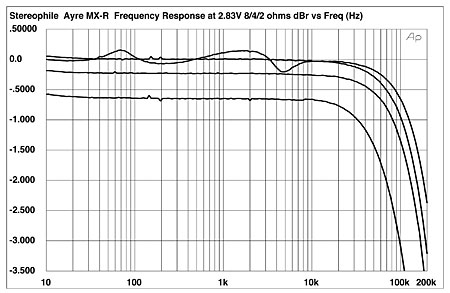
Fig.1 Ayre MX-R, frequency response at 2.83V into (from top to bottom at 2kHz): simulated loudspeaker load, 8, 4, 2 ohms (0.5dB/vertical div.).
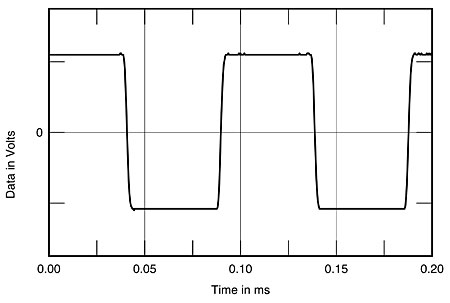
Fig.2 Ayre MX-R, small-signal 10kHz squarewave into 8 ohms.
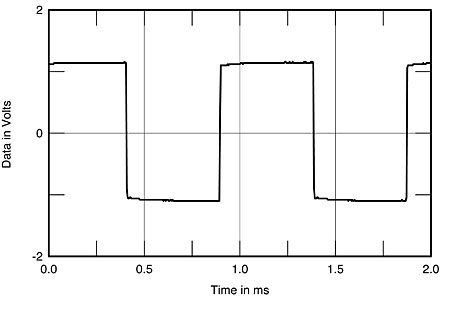
Fig.3 Ayre MX-R, small-signal 1kHz squarewave into 8 ohms.
To its credit, the MX-R seemed immune to all the various grounding schemes I tried between it and the Audio Precision test set. However I hooked it up, the unweighted, wideband signal/noise ratio (ref. 2.83V into 8 ohms) was a good 79.6dB, this increasing to an excellent 90dB when the measurement bandwidth was restricted to the audioband and to 92.5dB when A-weighted.
As well as having low noise, the MX-R output a lot of power. Fig.4 shows how the THD+N percentage changed with output power into 8, 4, and 2 ohms. Taking 1% THD+N as the clipping point and driving the MX-R with a 1kHz sinewave, the amplifier clipped at no less than 360W into 8 ohms (25.6dBW), a useful 0.8dB above the specified 300W. The MX-R clipped at 640W into 4 ohms (25.05dBW), again higher than specified. However, when I tested the continuous output power into 2 ohms (fig.4, top trace), the amplifier shut itself off at 775W (22.9dBW) and the front-panel LED went from a continuous blue to flashing red.
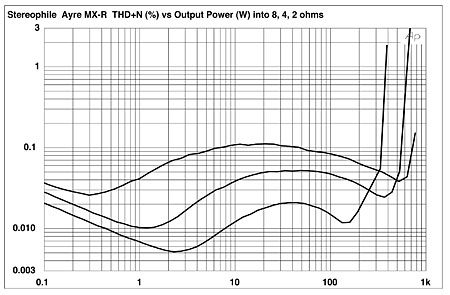
Fig.4 Ayre MX-R, distortion (%)vs 1kHz continuous output power into (from bottom to top at 100W): 8, 4, 2 ohms.
This was the final measurement I performed, so there was no impact on the testing. However, I needed to know what had happened, so I turned the amplifier over and removed the bottom plate (which also gave me the opportunity to admire its construction). Two of the four fuses on the single printed circuit board had blown. Unfortunately, when I replaced them, the replacements also blew, meaning that something more significant had broken (footnote 1). (There is a reason I always leave this test till last!) But to be fair to Ayre, asking the MX-R to deliver a continuous 775W into 2 ohms is something that, it is safe to say, will never happen with real-life music signals and loudspeakers.
Fig.4 implies that the MX-R's THD increases with decreasing impedance, and this is also apparent in fig.5, which shows how the THD+N percentage changes with frequency. Even with the relatively low output level (5V), the THD more than doubles with each halving of load impedance, though it remains low in absolute terms into the higher impedances. This is illustrated in the next pair of graphs. The bottom trace in fig.6 shows the distortion+noise residual waveform at 1W into 8 ohms. The level is 0.00675%, and I averaged 32 readings to reduce the contribution of the random noise. The dominant harmonic is clearly the subjectively innocuous second. By contrast, fig.7 was taken at the same output voltage into 4 ohms, with again 32 readings averaged. Not only is the THD higher, at 0.014%, but the distortion content is now primarily third harmonic.
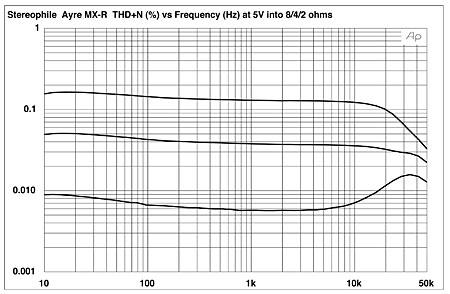
Fig.5 Ayre MX-R, THD+N (%)vs frequency at 5V into (from bottom to top): 8, 4, 2 ohms.
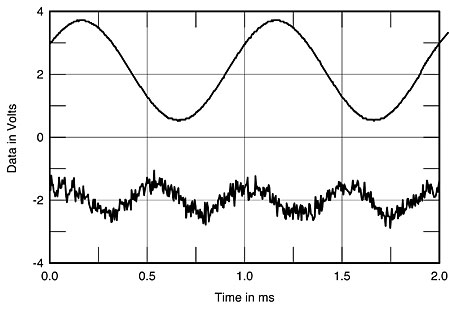
Fig.6 Ayre MX-R, 1kHz waveform at 1W into 8 ohms (top), 0.00675% THD+N; distortion and noise waveform with fundamental notched out (bottom, not to scale).
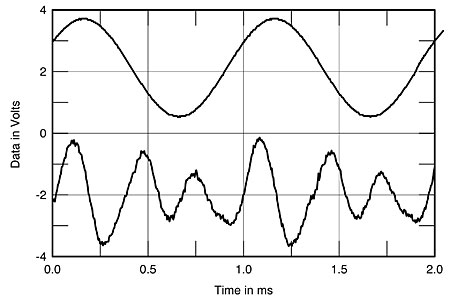
Fig.7 Ayre MX-R, 1kHz waveform at 2W into 4 ohms (top), 0.014% THD+N; distortion and noise waveform with fundamental notched out (bottom, not to scale).
This is shown in a different way, as FFT-derived spectra, in figs.8 and 9. (Note that the higher-order harmonics visible in these two graphs are almost certainly mathematical artifacts.) The second harmonic can be seen to increase into the lower impedance, from –99dB to –84dB, but the third harmonic increases by a larger extent, from –100dB to –80dB. Odd harmonics predominate at low frequencies and high currents (fig.10), with the even harmonics at the same level they were at low powers.
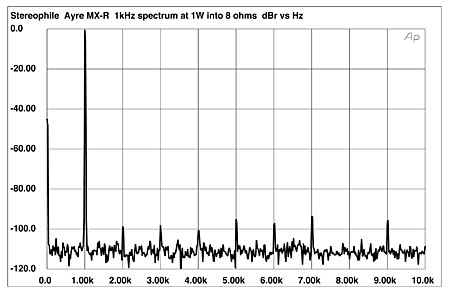
Fig.8 Ayre MX-R, spectrum of 1kHz sinewave, DC–10kHz, at 1W into 8 ohms (linear frequency scale).
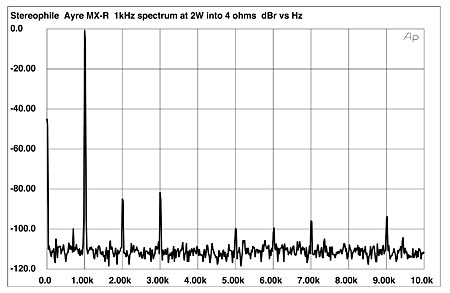
Fig.9 Ayre MX-R, spectrum of 1kHz sinewave, DC–10kHz, at 2W into 4 ohms (linear frequency scale).
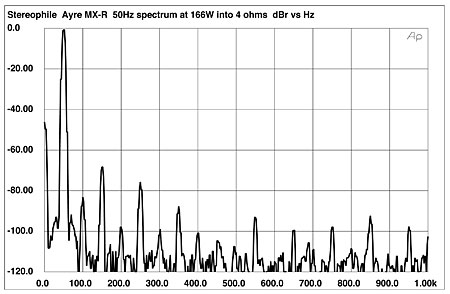
Fig.10 Ayre MX-R, spectrum of 50Hz sinewave, DC–1kHz, at 166W into 4 ohms (linear frequency scale).
Finally, the Ayre MX-R produced a very low level of second-order intermodulation distortion, even at high powers (fig.11), though some higher-order spuriae are visible.
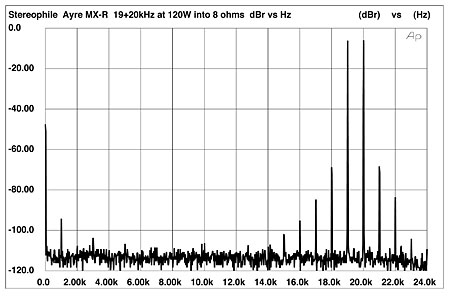
Fig.11 Ayre MX-R, HF intermodulation spectrum, DC–24kHz, 19+20kHz at 120W peak into 8 ohms (linear frequency scale).
Overall, this is a good set of measurements, as I have come to expect from Ayre's Charles Hansen. Most of the idiosyncrasies can be explained by the assumption that the MX-R's circuit uses a low level of overall loop negative feedback. Sorry I broke your amplifier, Charlie.—John Atkinson

Sexy you say? You are wrong it is sexy, extremely, audiophiles would give sex for a yr to own it. The contours are made to
fit its' sleek bod. Crank it with a Mystere preamp or something and you're in there